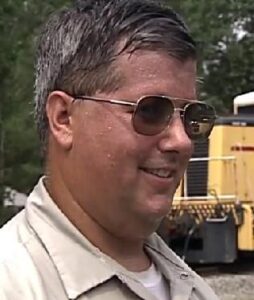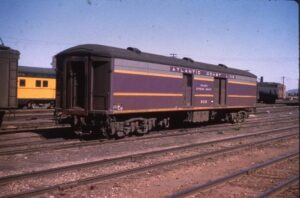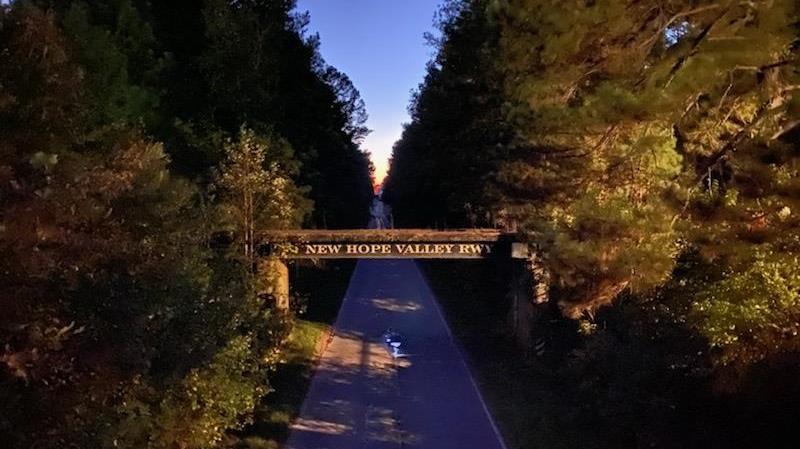Volume 62 – Issue 10 1 October 2022
From the Brass Hat
Hello everyone. Fall is officially here and the busy time of the year is on top of us. Halloween trains begin on 15 October, but prep has already begun in earnest. Most of the usual things will be seen along the line, but some new things are in the works as well. Be on the lookout for some new visitors along the tracks, including someone tall, dark and not-so-handsome. We will require a full effort from our volunteers in October if we are to succeed.
some new things are in the works as well. Be on the lookout for some new visitors along the tracks, including someone tall, dark and not-so-handsome. We will require a full effort from our volunteers in October if we are to succeed.
This year we are particularly short on WITCHES for the second and third dates. As usual, a number of our operating crew will be tasked with non-operating acting jobs, so turnout for the train crew will be more important than usual. This includes the parking lot, since we are running five trains per day and folks usually like to hang out and see all the decorations longer than usual. Please do your best to be available on 15, 22 and 29 October. We are sold out on all 15 trains for this event. For those who may not know, we generally have up to 70% of our ridership for the year from the Halloween and Christmas trains!
Don’t forget that we have a Quarterly membership meeting on 8 October at 10AM at the gazebo (and rescheduled Safety training at 8AM the same morning) AND HOPEFULLY SOME ASSISTANCE DECORATING. Ballots for new member applicants and ballots for the Board of Directors’ election are due at that time. We will discuss, among other things, the newly adopted Emergency Action Plan which was developed by a group from the Board and members with experience from other organizations. This comprehensive plan covers most of the things we could encounter, so folks need to be familiar with its contents should something arise.
Other events recently include preparing some of our cabooses for repainting, getting our large crane repaired so we can complete the truck swap on car 101 (just in time for Halloween), new battery chargers for locomotive 1686 and a host of other projects making our museum better. Thanks to everyone who has helped on these unsung efforts.
Respectfully submitted,
Chris Tilley
President, NCRM
New Member Orientation Session
The next new member orientation session will be on Saturday, 12 November from 10 am to noon. It will be held under the covered area behind the yard office followed by a tour of the property along with some of our ongoing projects.
The orientation session is intended to give new members information about our history, bylaws, how to get information, who’s who, and most importantly how to get involved as a volunteer (and have fun). This session is open to those who have been members for up to 2 years. This is not a substitute for the rules and safety training sessions necessary to get involved with train operations, but we will explain how to attend those sessions, too. If you are interested in attending, please RSVP to either Dennis Winchell or Victor Varney.
NCRM’s Ex-ACL Baggage-Express Car
by Larry Goolsby, ACL&SAL HS
The North Carolina Railway Museum’s ex-Atlantic Coast Line baggage-express car has a long and interesting history. With a good deal of “industrial archeology” undertaken recently on the car, along with available photographs and railroad records, its story has been put together with a high degree of confidence starting with construction over a century ago up. Using markings and other information found on the car, and comparing these with photos, documents, and drawings, we have established that the car was built as ACL 704 in 1916 and have documented changes made to it along the way.
In 1916 through 1918, ACL purchased a group of 15 cars from the Pullman Company, numbered 704-718 and in railroad class F-9, that contained a combination of Railway Post Office (RPO) and baggage/express space. The baggage compartment carried passengers’ luggage, trunks, and other baggage as well as express packages, while the RPO section was a rolling version of a U.S. Post Office where postal clerks received mail along the train’s route, sorted it, and readied it for unloading at the proper destinations. A hook on the car’s side even allowed outgoing bags of mail suspended from lineside poles to be snagged without stopping the train.
These cars measured just under 75 feet long overall, with 30 feet of the inside length outfitted for postal use and the remaining 39 interior feet assigned to baggage space. The accompanying Pullman builder’s photo of ACL 714 shows a sister car from the 704-718 group, built in 1918 but essentially identical to 704. The left half is the RPO section with the baggage area to the right.

Pullman photo-ACL & SAL HS Collection
Baggage-RPO cars were used on many ACL passenger trains over the years, with combination cars such as this one assigned to handle a medium volume of mail. ACL also had full-length RPO cars with 60-foot mail compartments for maximum capacity, with no baggage section. (Some railroads also had baggage-RPO cars with just 15-foot compartments for light-duty runs.) ACL’s main passenger route was from Richmond to Florida, with connecting routes to other southeastern cities such as Portsmouth (Norfolk), Wilmington, Augusta, Atlanta, and Montgomery. These cars, together with others designed only for baggage and express, were carried at the front of the train and were known collectively as “head-end” cars.
Most of the F-9 baggage-RPO cars were modernized in the early 1950s. The photo of sister car 713 shows one version; the car’s exterior remained mostly as built, other than a new set of high-speed class T-28-A trucks with roller bearings, but its RPO interior was upgraded according to the latest Post Office specifications. This photo illustrates the striking aluminum and purple paint scheme ACL applied from the early 1950s to 1957 to many of its heavyweight passenger cars, and which could still be seen on some cars into the late 1960s. [color photo of a different class car to demonstrate the above-mentioned paint scheme- ed]
Other cars in the group, including ACL 704, also received a makeover of their exterior – notably a streamlined “turtleback” roof that matched the profile of lightweight passenger cars and smooth welded side panels replacing much of the original riveted construction. Such cars were also equipped with trucks and other upgrades that allowed speeds up to 100 mph on the railroad’s highest-priority passenger trains like the New York-Miami Champion. The photo of 704, taken at Augusta in 1965, illustrates these changes as applied by ACL’s Rocky Mount, N.C., shops in 1954; the ACL diagram drawing shows No. 704 and three other F-9s that were rebuilt to the same appearance.
By the time of the 1965 photo, most heavyweight ACL cars had been repainted in a simplified scheme of dark (Pullman) green bodies with yellow lettering; the 704 no doubt also received purple paint when first rebuilt. No. 704 underwent another major change in late 1966, when the RPO fixtures were removed and the entire car interior opened up to carry baggage and express. By this date the Post Office had begun using planes and trucks to carry most mail, and most RPO cars were either scrapped or converted to other uses. ACL and other railroads were still carrying significant quantities of express as well as storage mail that did not need sorting enroute, and still needed equipment for express use. This modification also included a new number, 1665. The accompanying photo of sister 1666 shows how 1665 would have looked; the former RPO portion was at left, with the small door remaining but three small windows removed.
Then in 1967, ACL was merged into the Seaboard Coast Line. No. 1665 was assigned a new SCL number, 4585, but few heavyweight cars were actually repainted for SCL. SCL and other railroads discontinued an increasing number of passenger trains in the late 1960s due to declining patronage, and by the time Amtrak took over the nation’s remaining passenger trains in 1971, few were left that carried any head-end cars. The remaining head-end cars on SCL’s roster were soon either scrapped or downgraded to maintenance-of-way service. By the early 1970s the 1665 had been renumbered again, this time into the SCL MofW series as 762909.
In 1983 Seaboard Coast Line was merged into the Seaboard System Railroad, and four years later SBD became part of CSX Transportation. The car’s number changed again, to SBD/CSX 982909; traces of this number remain on the car now.
The exact date of the car’s last use by CSX is unknown, but in any event, it was available for donation when the Museum acquired it in the late 1990s. Today this historic car is still here in its 106th year, ready for its latest role in a long and useful career.
Larry Goolsby is the editor of Lines South Magazine, published by the Atlantic Coast Line & Seaboard Air Line Historical Society. Used With Permission.
[Editor’s note: If you have photos or other info about long-ago events at the NCRM, please contact your acting editor. You can submit your own “Back in the Old Days…” article with pictures about anything (within reason) from our past for the Telegrapher. If you can rough out the ideas, we can work with you to turn it into an article to benefit the entire membership. – CT]
Back in the Old Days: The First East Carolina Chapter Open House – as told by M. Gray Lackey
 The date on the deed to the property is 15 February, 1983. I do not know when the first nine pieces of equipment arrived as that was before my time as a member, I have been told December of that year, but the first open house was in the late summer, I believe in August or September of 1984.
The date on the deed to the property is 15 February, 1983. I do not know when the first nine pieces of equipment arrived as that was before my time as a member, I have been told December of that year, but the first open house was in the late summer, I believe in August or September of 1984.
I was a member of the Greensboro NRHS at the time and the word was put out to all the local groups that an open house was to be held with train rides on the newly acquired property.
The Chapter’s equipment consisted of 45ton GE #67, 50ton Whitcomb #1 (now #70) on blocks for truck work, Seaboard Air Line caboose 5228, Aberdeen and Rockfish caboose 308, two USMC flatcars (now 100, 101), Southern RPO baggage 188, and the two Southern boxcars which were picked up at Wilson and Durham – those were to scrapped on site and it was easier on local management to give the cars away with the move than arrange for an onsite scrapper.
So, upon arrival that morning the train was set up for the first trip. Locomotive-caboose-flatcar-caboose. There were probably about 50 people, and everyone was riding everywhere. Locomotive, cabooses, flatcar. I rode the flatcar and sat down on the deck, there were no seats or sides just the deck and that was it. The trees were a lot thinner and there were no houses anywhere. The locomotive ran around at Hill just like today and we went back to Bonsal. Just like now, there was no run around at Bonsal.
Remember I said the Whitcomb was up on blocks with the trucks out from under it, so how do you get the cars on the south of the locomotive with no other motive power? By John Deere tractor of course! Once all the passengers were off, the train was pushed out of what we now call the house track just past the switch. A chain was attached to the steps of a caboose and the tractor pulled it over the hump in Daisy Street and then dropped it off to free roll, stopping with a hand brake application. The locomotive then pulled the flatcar and other caboose to the switch, repeat process this time with two cars. Then the locomotive moved over and put everything back together and to a spot.
Between trips the locomotive had to be fueled as each end had only a five gallon can hanging in the hood. There was gunk in the fuel tank and the five-gallon cans were the answer to the gunk. It took about four gallons per end to make a trip, do switching and idle. The locomotive idled all day as it took an external generator to charge and jump the batteries. Later on, I would learn that if you wanted to run a train, you had to bring five gallons of diesel fuel when you came to Bonsal plus gas for the generator. Many an old milk jug brought fuel (and water, since there was no well) to Bonsal to keep the locomotive running.
More people had arrived by the time of the second trip and I wanted to ride the locomotive. The train looked like an Indian commuter train. The locomotive had people in the cab and all four corners, caboose platforms and of course the flatcar deck. I watched the final switching moves and headed home. That was my first visit to Bonsal.
[Full disclosure, there has been a management and philosophy change since this event. – ed]
Area Police Youth Program Charter Train Ride 5 November
by Victor Varney
Wells Fargo Advisors of Chapel Hill has again graciously offered to sponsor a charter train for a deserving group of kids. Last year they sponsored a charter train for the Horse and Buddy riding therapy group just up Old US Hwy 1 from Bonsal Yard.
This year we have invited four area police departments to bring disadvantaged kids in their community outreach youth programs. As many of you know, the Durham Police Department’s Youth Athletic League visited us many times for weekday rides this past summer. T
he police departments coming are from Apex, Cary, Durham, and Pittsboro. Each will get their own excursion car and can bring up to 50-60 riders (youth and officers). The train runs at 11 am on Saturday November 5, rain or shine. There is no problem if they might see some of our Halloween decorations not yet taken down.
After the train ride, we have invited all four groups to stick around and have their own picnics, visit all our displays, see the garden railroad, and meet the loco engineer in the cab. A special group picture after the train ride will include a police car from each police department and all the participants next to one of our locos.
We know many of our volunteers will be pretty worn out after running the Halloween trains. That said, this charter train is for a deserving bunch of kids, and will help us improve our relationship with four important police departments and towns in our area. So please get this on your calendar now and respond to Chris when he sends out his crew call in late October. If you have any questions, contact Victor.
NRHS September Conference in Arkansas
by Victor Varney
The NRHS held their fall conference in Springdale, Arkansas, Sept 23-25. There are usually two conferences each year held in the spring and fall. These are short 2- to 3-day events with the advisory council and board meetings happening one full day with an added day or two for visits to area rail attractions. The 5- to 6-day conventions happen only once each year usually in the summer.
At the Arkansas conference, the new slimmed down board was installed along with all officers and committee leaders selected. Two years ago, the bylaws were changed to reduce the board from 25 members to now 11 members. The new president is Tony White. The NRHS is very strong financial shape these days with now 5,000 plus members. The financial statements can be easily found on the NRHS website. In addition, the separately incorporated NRHS Fund that professionally manages NRHS cash reports having over $1M in investments and cash. The NRHS Fund provides money as needed to support NRHS programs like Railcamp and Heritage Grants.
A very important announcement was made regarding the John Emery Rail Heritage Trust which has asked the NRHS to become involved with reviewing and approving Heritage Trust grants. For those who may not know, the Heritage Trust is the largest annual funder of rail preservation projects each year. Around $500K a year or two ago vs. only $100K for the current NRHS Heritage Grant program.
During the conference there were outings on two days on the Arkansas & Missouri Railroad, a 150-mile freight short line that also runs a consist of passenger cars for visitors to ride the line on 5 to 6-hour excursions. They are especially well known for their large fleet of Alco locomotives.

A drone shot of NRHS members on Sunday Sept 25. Photo by Mike Yuhas
If you have any questions or want to know how to join the NRHS, contact the NCRM’s NRHS advisory council rep Victor Varney.
Once Upon a Hurricane
by Richard Lasiter
When I was President of the East Carolina Chapter, NRHS, I got a phone call from a CP&L meteorologist about 10 PM warning us that the eye of Hurricane Hugo was predicted to pass over the Shearon Harris Nuclear Plant before dawn. Wind gusts of over 100 mph were indicated by the hurricane models. CP&L planned to do an emergency shutdown of the atomic reactor by injecting boron into the core because there wasn’t enough time to shut it down normally. This would have poisoned it until the core elements were removed and replaced. They were that worried.
I called a crew and told them to come to Bonsal immediately with all the chains and rope that they could find. Back then, we only had caboose No. 308, caboose No. 5228, the RPO, two flat cars and the two SR boxcars. General agreement among the 6 ECC that showed up was that we should fasten down the carbodies and let the locomotives go. We started tying down the cars and about 1AM we got a call from CP&L that Hugo had made a sudden sideways swing almost 90 degrees to the left and was now headed for Charlotte! The head nuclear technician who was to do the crash shutdown had just driven up and was told to go home. We did the same and came back the next day to clean up. Hugo went on to create havoc around Gastonia.
[Editor’s note: Hugo made mainland U.S. landfall at Sullivan’s Island, SC–near Charleston–as a Category 4 storm on 21 September, 1989.]
October (+) Museum/Operating Schedule:
8 October 0800 Rules & Safety training/testing (change)
8 October 1000 Quarterly Membership Meeting
8 October – Halloween decorating (running behind due to hurricane) please
11 October Strategic Planning Group 7-9PM @ New Hill Community Center
15 October Halloween “A” Rides 1-9PM
20 October 1800 Board of Directors Meeting @ New Hill Community Center
22 October Halloween “B” Rides 1-9PM
29 October Halloween “C” Rides 1-9PM
5 November Police Special Charter 11AM
9 November Wednesday ride 1030AM
If you do not receive crew calls, please contact the crew caller if you are interested in participating!
The End








